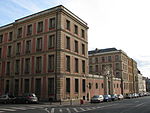Roman Catholic Diocese of Versailles
1801 establishments in FranceBishops of VersaillesReligious organizations established in 1801Roman Catholic dioceses and prelatures established in the 19th centuryRoman Catholic dioceses in France

The Diocese of Versailles (Latin: Dioecesis Versaliensis; French: Diocèse de Versailles) is a Latin diocese of the Catholic Church, in France. The diocese, headed by the Bishop of Versailles, was established in 1801. Until then, its territory had mostly been part of the Archdiocese of Paris and the Diocese of Chartres. It was centred on Versailles.
Excerpt from the Wikipedia article Roman Catholic Diocese of Versailles (License: CC BY-SA 3.0, Authors, Images).Roman Catholic Diocese of Versailles
Place Saint-Louis, Versailles
Geographical coordinates (GPS) Address Nearby Places Show on map
Geographical coordinates (GPS)
| Latitude | Longitude |
|---|---|
| N 48.7985 ° | E 2.12487 ° |
Address
Place Saint-Louis
78000 Versailles, Saint-Louis
Ile-de-France, France
Open on Google Maps










